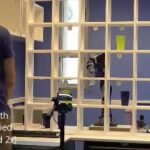 I’ve written a number of times about how new technologies are helping people rehabilitate from injuries, whether it’s virtual reality, gaming or even zero gravity treadmills.
I’ve written a number of times about how new technologies are helping people rehabilitate from injuries, whether it’s virtual reality, gaming or even zero gravity treadmills.
In a recent paper, a team from Ben-Gurion University of the Negev have highlighted how a robotic system that can play Tic Tac Toe with patients can improve their rehabilitation. The game was designed to help people exercise the muscles required to do basic daily tasks, like drinking from a cup.
“Playing Tic Tac Toe with a set of cups (instead of X’s and O’s) is one example of a game that can help rehabilitate an upper limb,” the team say. “A person can pick up and place many cups while enjoying a game and improving their performance of a daily task.”
Better rehab
These kind of tasks are common in rehabilitation, and the researchers compared the performance of volunteers interacting with the robot versus an array of computer-controlled LED lights. All of the volunteers found the robotic system interesting, reporting that it was everything from more human-like to more interesting and appealing.
This resulted in all of the group preferring to play an extra couple of games with the robotic system, although interestingly, if asked if they wanted to play 10 extra games, older adults chose the robotic system whereas younger adults went with the LED lights.
“Some of the young adults complained that the robot moved too slowly; therefore, they preferred the quicker system when asked to play many more games,” the researchers say. “That indicates a need to personalize the speed of the robot to each participant.”
Interestingly, the robotic system was found to influence the movement of the volunteers. They were found to move much slower when playing against the robot than when they played against the lighting system.
The researchers believe this is because the robotic system is more life like, and therefore this influences how people interact with it. The team are buoyed by their findings, and next hope to test the system on people rehabilitating after a stroke.
It’s a fascinating project, and you can see the robot in action via the video below.